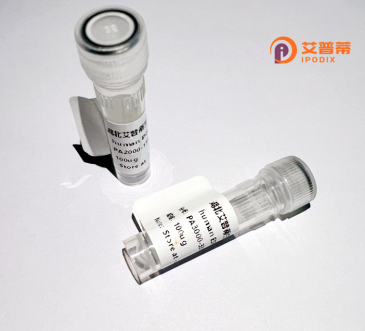
| 纯度 | >90%SDS-PAGE. |
| 种属 | Human |
| 靶点 | TRIM4 |
| Uniprot No | Q9C037 |
| 内毒素 | < 0.01EU/μg |
| 表达宿主 | E.coli |
| 表达区间 | 1-500 aa |
| 活性数据 | MEAEDIQEEL TCPICLDYFQ DPVSIECGHN FCRGCLHRNW APGGGPFPCP ECRHPSAPAA LRPNWALARL TEKTQRRRLG PVPPGLCGRH WEPLRLFCED DQRPVCLVCR ESQEHQTHAM APIDEAFESY RTGNFDIHVD EWKRRLIRLL LYHFKQEEKL LKSQRNLVAK MKKVMHLQDV EVKNATQWKD KIKSQRMRIS TEFSKLHNFL VEEEDLFLQR LNKEEEETKK KLNENTLKLN QTIASLKKLI LEVGEKSQAP TLELLQNPKE VLTRSEIQDV NYSLEAVKVK TVCQIPLMKE MLKRFQVAVN LAEDTAHPKL VFSQEGRYVK NTASASSWPV FSSAWNYFAG WRNPQKTAFV ERFQHLPCVL GKNVFTSGKH YWEVESRDSL EVAVGVCRED VMGITDRSKM SPDVGIWAIY WSAAGYWPLI GFPGTPTQQE PALHRVGVYL DRGTGNVSFY SAVDGVHLHT FSCSSVSRLR PFFWLSPLAS LVIPPVTDRK |
| 分子量 | 57.4 kDa |
| 蛋白标签 | His tag N-Terminus |
| 缓冲液 | PBS, pH7.4, containing 0.01% SKL, 1mM DTT, 5% Trehalose and Proclin300. |
| 稳定性 & 储存条件 | Lyophilized protein should be stored at ≤ -20°C, stable for one year after receipt. Reconstituted protein solution can be stored at 2-8°C for 2-7 days. Aliquots of reconstituted samples are stable at ≤ -20°C for 3 months. |
| 复溶 | Always centrifuge tubes before opening.Do not mix by vortex or pipetting. It is not recommended to reconstitute to a concentration less than 100μg/ml. Dissolve the lyophilized protein in distilled water. Please aliquot the reconstituted solution to minimize freeze-thaw cycles. |
1. **文献名称**: "TRIM4 modulates type I interferon induction and cellular antiviral response by targeting RIG-I"
- **作者**: Zhang L, et al.
- **摘要**: 本研究揭示TRIM4通过与RIG-I相互作用促进其K63泛素化,增强抗病毒信号通路,正向调控Ⅰ型干扰素产生,支持其在先天免疫中的关键作用。
2. **文献名称**: "TRIM4 regulates mitochondrial dysfunction and autophagy in Parkinson’s disease models"
- **作者**: Wang Y, et al.
- **摘要**: 研究发现TRIM4在帕金森病模型中通过泛素化调控PINK1/Parkin通路,影响线粒体自噬,其表达下调可能导致神经元损伤,提示与神经退行性疾病的关联。
3. **文献名称**: "Structural and functional characterization of TRIM4 ubiquitin ligase activity"
- **作者**: Li X, et al.
- **摘要**: 通过晶体结构解析和生化实验,阐明了TRIM4的B-box结构域对其E3泛素连接酶活性的调控机制,揭示了其底物识别和催化泛素链形成的分子基础。
4. **文献名称**: "TRIM4 inhibits breast cancer metastasis by regulating E-cadherin expression"
- **作者**: Chen H, et al.
- **摘要**: TRIM4通过介导转录抑制因子Snail的泛素化降解,上调E-cadherin表达,抑制上皮-间质转化(EMT),降低乳腺癌细胞的侵袭和转移能力。
TRIM4 (Tripartite Motif-containing Protein 4) is a member of the TRIM family, characterized by a conserved N-terminal tripartite motif comprising a RING finger domain, one or two B-box domains, and a coiled-coil region. These domains enable TRIM4 to function as an E3 ubiquitin ligase, facilitating the attachment of ubiquitin molecules to target proteins, which can regulate protein stability, localization, or interactions. Primarily expressed in the brain and immune-related tissues, TRIM4 is implicated in innate immunity, inflammatory responses, and cellular stress pathways. Studies suggest it may modulate antiviral defense mechanisms by interacting with viral proteins or signaling intermediates, such as those in the NF-κB and interferon pathways. Additionally, TRIM4 has been linked to neurological functions, with altered expression observed in neurodegenerative conditions and gliomas, though its precise role remains unclear. Recent research highlights its potential involvement in cancer, where it may act as an oncogene or tumor suppressor depending on context, influencing apoptosis and proliferation via ubiquitination-dependent mechanisms. Despite these insights, TRIM4’s full biological repertoire, including its physiological substrates and regulatory networks, remains understudied. Its dual roles in immune regulation and disease pathogenesis make it a compelling target for further exploration in both basic and translational research.
×